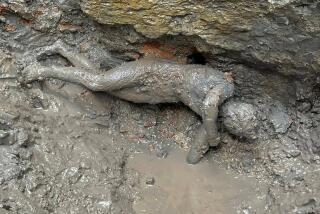Developments in Brief : One Bas-Relief Offers 2 Styles of Greek Art
- Share via
UC Berkeley archeologists have found a three-foot marble sculpture that they say may provide critical information about an important gap in the history of ancient Greece.
The bas-relief was discovered during a dig they supervised at the site of the 2,600-year-old Temple of Zeus and its 30,000-seat stadium in Nemea in southern Greece.
Stephen G. Miller, a classics professor at Berkeley, said it is important because it is one of the few that bridge two distinct types of Greek art.
The sculpture dating from 475 BC shows a man standing in bold relief and a seated woman whose form is virtually flat. The man is carved in the pattern of the Classical Period, for which Greece is best known, while the woman reflects the style of the Archaic Period preceding the Persian War.
“His weight rests on his left foot, which is a form of sophistication not found in Greek art until after the Persian War,” Miller said. “The classical period began then and produced art that was extremely naturalistic--except that the subjects’ warts were eliminated.”
The discovery was made in November in an area where 10,000 objects (mostly small and insignificant) have been uncovered since the Nemea digs began in 1974. The site contained an ancient stadium that had been buried under 18 feet of earth. The stadium was a center for more than just athletic competition, Miller said.
“It was like a state fair, with people coming in by the tens of thousands from all over the Greek world, which extended to Asia, Africa and Sicily,” he said. “Sculptors and painters were there to hawk their wares, and so were philosophers, peddlers and prostitutes.”
Miller is on leave from UC while serving as director of the American School of Classical Studies in Athens. He was in Berkeley recently to lecture on Nemea.
More to Read
Sign up for Essential California
The most important California stories and recommendations in your inbox every morning.
You may occasionally receive promotional content from the Los Angeles Times.













